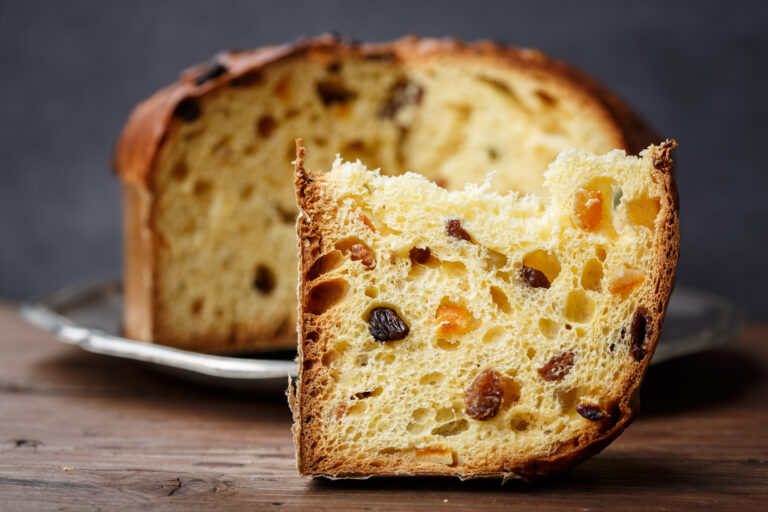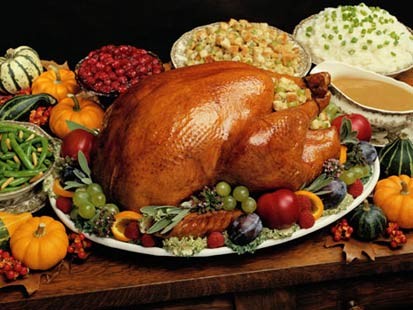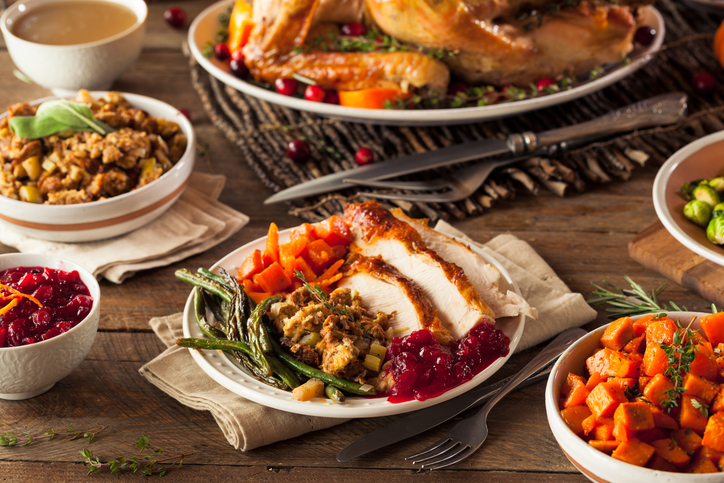
The majority of holiday celebrations around the world involve indulging in delicious feasts; however, the foods we eat and the traditions we practice vary. In Italy, elaborate dishes are the center of everyday meals and are emphasized at Christmas! If you’re looking to expand your horizons this holiday season, use the following tips to host an Italian-inspired, multi-course meal that embraces age-old Italian customs and creates priceless (and delicious!) memories with friends and family.
The Christmas Eve meal is traditionally meatless – instead, Italians enjoy a diverse variety of fish, also known as the Feast of the Seven Fishes. Don’t let this seven-course feast intimidate you. Fill your menu with familiar, easy-to-prep dishes that take some heat off of the host. Shrimp Toasts and seafood spreads containing crab, salmon or salted cod are crowd-pleasing starters that are perfect for preparing in advance. For the main courses, pasta and stews symbolize iconic Italian classics. Shrimp Alfredo, seafood linguine with clams or mussels, cioppino and Bouillabaisse are all dishes that showcase succulent seafood beautifully. Maple-Walnut Crusted Salmon and Classic Lobster Rolls are additional impressive dishes that make a big statement in your seafood lineup.
Don’t forget dessert! Both light and fluffy, panettone and pandoro are two Christmas cakes that your guests won’t want to miss. Panettone is studded with raisins or candied fruits, and pandoro is a moist, bright yellow cake (traditionally star-shaped) that’s dusted with powdered sugar. Serve these sweet treats with sauces like caramel, chocolate or maple syrup.
To follow ancient Italian tradition, keep the table set after everyone is finished eating; it’s believed that the Madonna (Mary) and baby Jesus will come to taste the food. The Christmas season in Italy begins December 8th and ends January 6th – providing many opportunities to practice and experience these time-honored traditions.

Written by Maureen Rowan Murphy, Manager Consumer Trends, Nutrition and Lifestyles
Hosting Thanksgiving for the first time can be a bit intimidating but it doesn’t need to be. The source of most angst comes from the fear of cooking a turkey when in fact, it is amazingly easy! Let this guide give you the confidence you need and take the guesswork out of preparing a delicious turkey for your special holiday meal.
Buying a Turkey
Turkeys are available in all sizes, whole or parts, fresh or frozen. Choosing between fresh or frozen turkeys is simply a matter of preference. There is no significant difference in quality.
Store fresh turkey in the refrigerator up to the sell-by date on the label or place in freezer if you plan on using after that date. Fresh turkeys are chilled after packaging to approximately 26°F to assure optimum quality, safety and freshness. It will feel firm to the touch, and ice may be found in the cavity as a result of moisture in the turkey freezing at 26°F (water freezes at 32°F, while protein (meat) doesn’t freeze until 0°F). If there are ice crystals, simply place breast-side down in cold water and allow to stand for 30 minutes or until no longer present.
If you’re purchasing a frozen turkey, you can do so at any time, but be sure to allow enough time for it to thaw. Whole turkey can be kept frozen in the freezer indefinitely, but should be cooked within 1 year for best quality.
Not sure what size turkey to purchase? Plan on approximately 1 lb. of turkey per person, which will allow for generous servings and leftovers. That being said, the larger the turkey, the greater the yield. A turkey larger than 16 lbs. will provide 2 servings/lb. i.e. a 20 lb. turkey will feed 40 people.
Thawing a Turkey
Thawing in the refrigerator is the preferred method of thawing. Estimate at least one day of thawing for every 4 lbs. of turkey. (You can insert a chart similar to the one you included in the email to me.) A thawed turkey can remain in the refrigerator for 1 or 2 days before cooking.
Although refrigerator thawing is preferred, don’t worry if you forgot to take the turkey out in enough time to thaw. You may also thaw the turkey in cold water or in the microwave if necessary.
To thaw in cold water: Place the turkey breast-side down in its original wrapper in cold water to cover, and change the water changed every 30 minutes to keep the turkey surface cold. Minimum thawing time will be approximately 30 minutes per pound, and the turkey must be cooked immediately upon thawing.
To thaw in the microwave: Check the manufacturer’s instructions for the size turkey that will fit in your microwave, recommended minutes per pound, and power level to use for thawing. The turkey must be cooked immediately once it is thawed.
Roasting a Turkey
Preheat the oven to 325°F. Place turkey breast-side up on a rack in shallow roasting pan – do not add water. Brush with cooking oil, melted butter or margarine if desired. Loosely tent with aluminum foil to prevent over browning, allow for maximum heat circulation, keep the turkey moist and reduce oven splatters. You’ll want to remove the foil tent 20 – 30 minutes before roasting is finished to allow the turkey to brown.
Most turkeys today come with pop-up timers, and they are generally accurate. If your turkey doesn’t come with one, it is recommended that a meat thermometer be used as it is the safest way to ensure that the turkey is done. The thermometer should be inserted into the inner most part of the breast/thigh area without touching bone. The turkey is done when the thermometer reaches a safe minimum internal temperature of 165°F. (Cooking to 165°F may give the appearance that meat at joint areas is undercooked, and although cooked, may be pink from the bone marrow. You may therefore choose to cook turkey to a higher internal temperature.) I like to use a meat thermometer even with a pop-up timer, not only for peace of mind so I know the turkey has reached 165°F, but also to check on how the turkey is progressing for timing of side dishes and serving.

Use this roasting chart only as a guide for cooking times.
TURKEY ROASTING CHART at 325°F
Weight (Pounds) Unstuffed (Hours)* Stuffed (Hours)*
8 – 12 2 ¾ – 3 3 – 3 ½
12 – 14 3 – 3 ¾ 3 ½ – 4
14 – 18 3 ¾ – 4 ¼ 4 – 4 ¼
18 – 20 4 ¼ – 4 ½ 4 ¼ – 4 ¾
20 – 24 4 ½ – 5 4 ¾ – 5 ¼
*Estimated cooking time
Important Safety Tips to Remember
- Don’t partially roast a stuffed turkey one day and complete roasting the next since interrupted cooking enhances possibility of bacterial growth.
- Roasting turkey at temperatures below 325°F is not recommended, as temperature is not high enough to destroy bacteria and could be unsafe.
To Stuff or Not to Stuff
The USDA’s Meat and Poultry Hotline actually recommends NOT stuffing the turkey. If it is stuffed, the stuffing may not reach the correct temperature of 165°F to kill bacteria even if the turkey itself reaches the safe minimum internal temperature of 165°F. Stuffing the turkey prolongs the cooking time and prohibits uniform cooking.
Here are some basic rules to follow if you do plan on stuffing the turkey:
Prepare stuffing just before it goes into the turkey. Dry ingredients can be mixed together and chilled ahead of time. Mix perishable (butter or margarine, mushrooms, sausage, oysters, broth, cooked celery and onions) ingredients however, just prior to placing stuffing inside the turkey and putting the turkey in the preheated oven. Stuffing should be moist, rather than dry, since heat destroys bacteria more rapidly in a wet environment
Stuff the cavity of the turkey loosely, about 3/4 cup stuffing per pound of turkey to allow the interior of the stuffing to reach the proper 165°F temperature in the center, and use a meat thermometer to ensure it has.
Remove the stuffing from the turkey as soon as it is completely cooled to prevent bacterial growth.
Storing Leftovers
Leftover turkey as well as any other holiday leftovers can be stored in the refrigerator for 3-4 days. If you don’t intend to eat by then, wrap the turkey well, place in the freezer, and use within 1 month for best eating pleasure.
Now that you’re ready to take on the Thanksgiving turkey, check out my Countdown to Thanksgiving to assist in planning, organizing and executing a Thanksgiving dinner sure to impress! Check it out here: https://bit.ly/2KMApJ0



